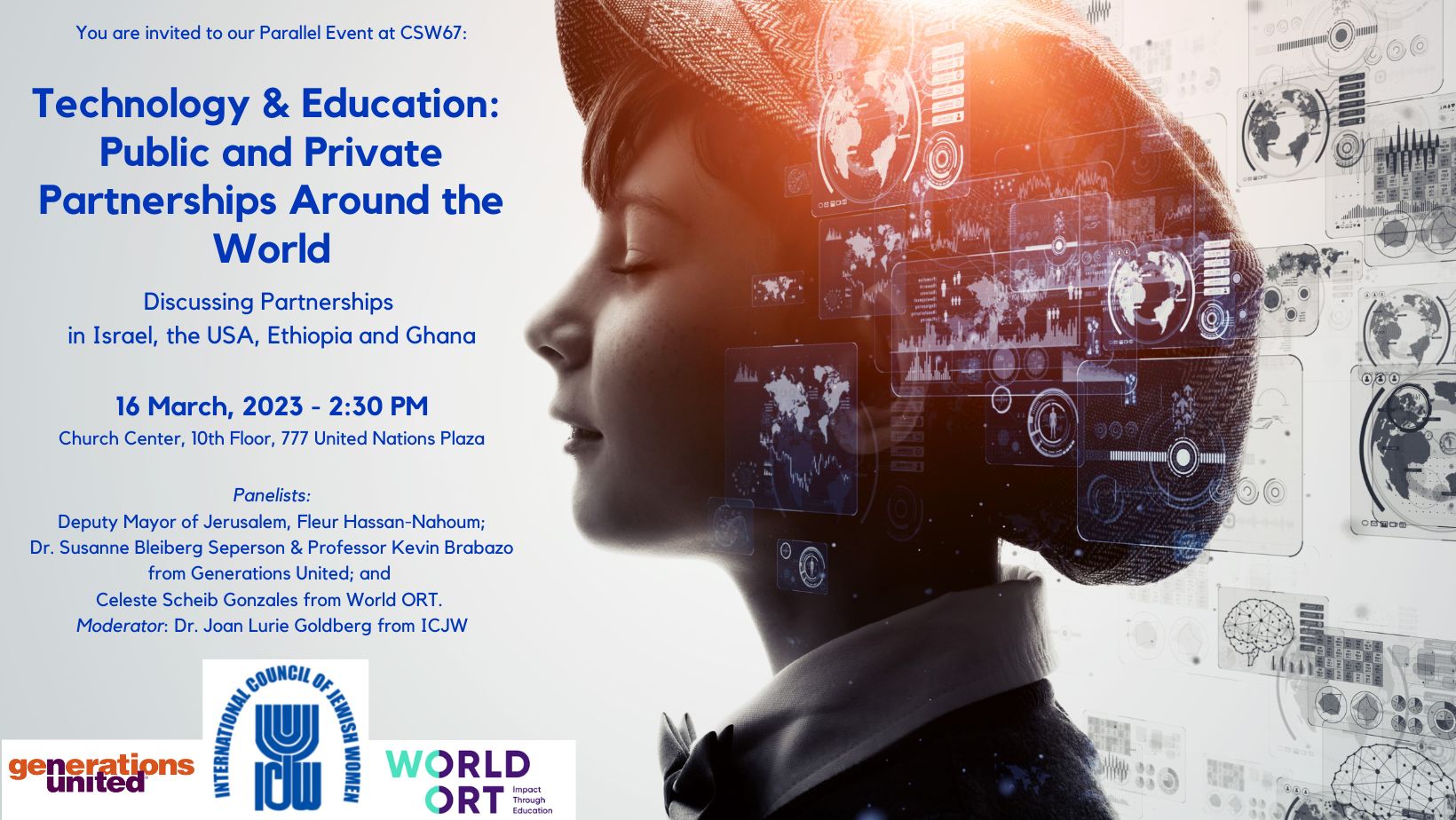Technology & Education: Public and Private Partnerships Around the World
ICJW co-sponsored a parallel event at the United Nations Commission on the Status of Women in New York, under the auspices of the CSW67 Forum, together with co-sponsors Generations United and World ORT.
Under the title “Technology and Education: Public and Private Partnerships around the world, the speakers discussed educational partnerships in Israel, the USA, Ethiopia and Ghana. The speakers were Deputy Mayor of Jerusalem, Fleur Hassan-Nahoum (via video), Dr. Susanne Bleiberg Seperson of Generations United (via Zoom), Professor Kevin Brabazon of Generations United, and Celeste Scheib Gonzales of World ORT. ICJW’s representative at the UN in New York, Dr. Joan Lurie Goldberg, was the moderator.
Deputy Mayor of Jerusalem, Fleur Hassan Nahoum discussed the challenges facing Israel’s biggest and most diverse city. Two large minorities, ultra-orthodox Jews and Palestinians – receive educations that do not prepare them to earn a living in an advanced, technological society. The result is that Jerusalem lags behind the rest of the country in the percentage of residents in the workforce, particularly in technology. The city is committed to change this by influencing the education these children are provided. The Palestinians in East Jerusalem, for historic reasons, are taught from Palestinian Authority textbooks. It is her goal to have the East Jerusalem schools use the same Israeli Arabic text books used in Arab towns all over the country. These books teach some Hebrew, some English, and the math and science needed to get tech jobs. She also mentioned an 8-month immersive program in Hebrew designed to enable Palestinian students to attend university.
Celeste Scheib Gonzales of World ORT is working on STEM learning and leadership pathways for women. She described the work in Ghana where ORT has developed a STEM program for girls’ education and empowerment. She believes in training trainers, and she has done that in Ghana with the assistance of Israelis who came and helped her. The program she described was established in 2020. A technology hub was set up in the local library in the town of Elmina to train mostly girls at first, but they are now including boys to ensure gender equality. The trainees learned Scratch (from MIT) and learn by doing. Her presentation, illustrated with slides of the participants in the program, was an excellent example of what grassroots education can do.
Dr. Susanne Bleiberg Seperson of Generations United discussed her work concerning the use of technology in working class and middle-class schools in the USA. This work is aimed at Sustainable Development Goal #4 – To ensure education for all students through high school by 2030. Dr. Seperson believes that technology is neither good nor bad, but its proper use can help us change practices. In studying what happened during the Covid pandemic, Dr. Seperson noted that poor male children using online learning suffered bigger deficits than middle class female children. Children did not just suffer learning deficits; there was also a lack of socialization, which has led to rising anxiety and a wide range of other difficulties. Aside from the formal educational effects, it is established that more households now use the internet, which widens the gap between rich and poor children.
Professor Kevin Brabazon of Generations United discussed a case study from Lalibela, Ethiopia. The goal of the study was to eliminate extreme poverty in the city by 2030. Professor Brabazon discussed various approaches:
- Supplemental insurance for older people.
- Adoption of a goal of working toward having all children finish high school.
- Intergenerational support – elders helping children have better social inclusion than other older people.
- Stabilizing families under stress, especially single parent families.
- Using older adult volunteers to act as surrogate grandparents.
In both Dr. Seperson and Professor Brabazon’s talks, it was apparent that technology is necessary to help close the gap between rich and poor, but this tactic will only be effective if technology is used with great skill.
